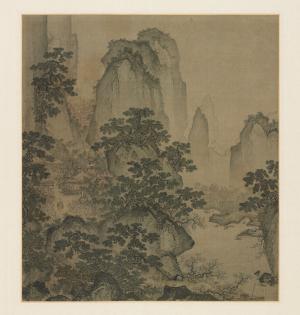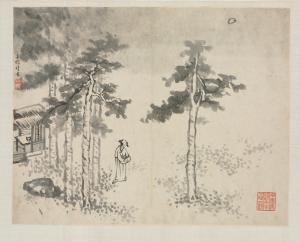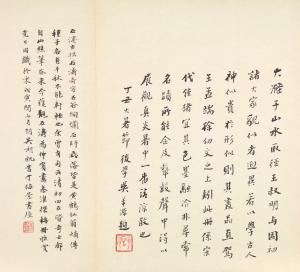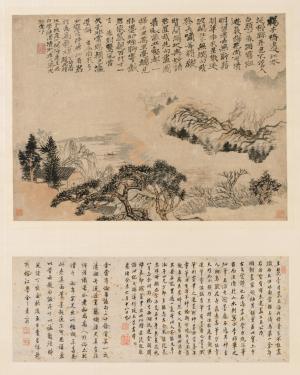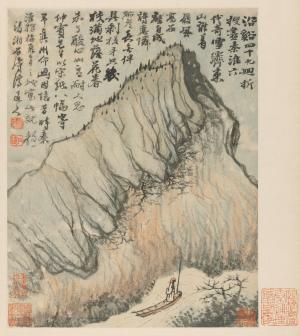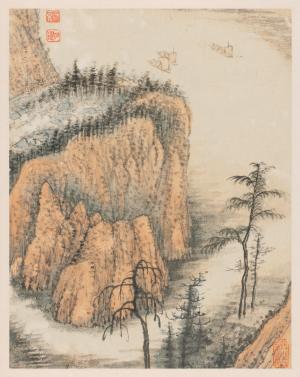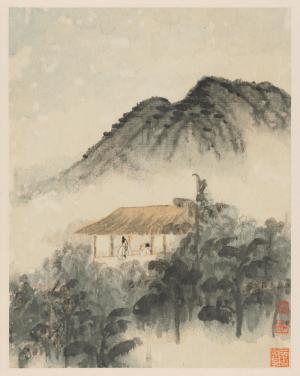Waiting for the Moon in the Mid Autumn Festival
詳細資料
John L. Severance Fund
Pan Zhengwei 潘正煒 [1791–1850]
Wu Yuanhui 伍元蕙 [active 1821–1851]
Abel William Bahr [1877–1959]
?-1973(Robert H. Ellsworth Ltd., New York, NY, sold to the Cleveland Museum of Art)
1973-The Cleveland Museum of Art, Cleveland, OH
Painting: 27.5 x 155 公分 (10 13/16 x 61 英吋)
絹本
[印] 石氏以明; 游戯翰墨.
Artist's 2 seals: Shi shi yi ming; You xi han mo
僊山樓觀
Title on frontispiece by Zhu Changyi 朱昌頤, dated 1849: Pavilions in the Mountains of the Immortals (Xian shan lou guan) by the Junior General Li of the Tang Dynasty.
1 inscription, dated 1639, and 1 seal of Xiao Yuncong 蕭雲従 (1596-1673).
Inscription by Xiao Yuncong:
This is a painting by the Junior General Li. The painting is damaged and cracked at many places. Many of the paper strips for backing have been missing since long ago, but the colors are still fresh as if they had just been applied and the ink still looks moist.
During the reign of Tianbao (742-756) of the Tang Dynasty, the Imperial Klansman Li Sixun was summoned to paint the walls of the Datong Hall. He was known as the "Senior General." His son, who came to be known as the "Junior General," was named Zhaodao.
Of the stone epitaph [Li Sixun bei, or the "epitaph of Li Sixun," one of the best known calligraphic monuments of the Tang Dynasty], engraved with the calligraphy of Li Beihai 李北海 [Li Yong 李邕, 678-747], more than half has fallen off. Why, in contrast, was this painting able to survive? Or could it be that despite the fact that the stone is hard and the silk is soft, their preservation or destruction depends on some other factors? Moreover, since they were titled nobility of imperial descent, it is doubtful that they had the leisure and the mood to indulge in such decorative and descriptive blue and gold painting for the mere amusement of their fellow men. Recently, I read the Yi zhou ming hua lu 益州名畫錄 [by Huang Xiufu 黃休復, preface 1005]. I found a certain Li Chin-nu who compared himself with Li Zhaodao 李昭道 and was called by the Sichuan people the Junior General Li. In a painting which he did, entitled Mt. Ch'ing-ch'eng, the architectural structure of the pavilions, terraces, bridges, and boats are meticulous and accurate. The horsemen on a spring outing are as small as grain and the wild geese among the clouds as tiny as dust. It was also said that he painted on silk of any length in accordance to specific commissions. Is it possible that this painting is one of his? Since that time 700 years have passed. Yet one of the two Junior General Li's must be our painter.
Formerly, there were the so-called "Four Excellents" in the Hall of Portraits of the Buddhist monk Wu-ta Kuo-shih: the [portrait] painting by Ch'ang Ts'an [act. ca. 881-888}, the calligraphy by Priest Tao-ying, the eulogy by Li Shangyin 李商隱 [813-858], and the landscape by Li Sheng [act. ca. 908-925]. This Li Sheng was styled Chin-nu and was also called Junior General Li.
In the tenth month of the Chi-mao year, the twelfth year of the Chongzhen era [1639], recorded by Xiao Yuncong of Wuhu.
trans. WKH
4 colophons and 30 additional seals:
1 seal of Xu Qianxue 徐乾學 (1631-1694);
1 seal of Li Chien 黎簡 (1747-1799);
1 seal of Chang Chin-fang (18th c.);
2 seals of Sun Erzhun 孫爾準 (1770–1832);
1 colophon and 2 seals of Zhang Weiping 張維屛 (1780-1859);
1 seal of Wu Rongguang 吳榮光 (1773-1843);
1 colophon and 2 seals of Luo Tianchi 羅天池 (1826 jinshi);
7 seals of Wu Yanhui 伍元蕙 (active 1821–1851);
2 colophons and 4 seals of Pan Zhengwei 潘正煒 (1791-1850);
9 seals unidentified.
水墨設色
金彩

